Answer these simple questions and we will find you the BEST prices
Which type of solar quotes do you need?
It only takes 30 seconds
100% free with no obligation

Get Free quotes from insulation specialists near you

Save money by comparing quotes and choosing the most competitive offer

The service is 100% free and with no obligation
Best Cavity Wall Insulation for Old Houses: Complete 2025 Guide

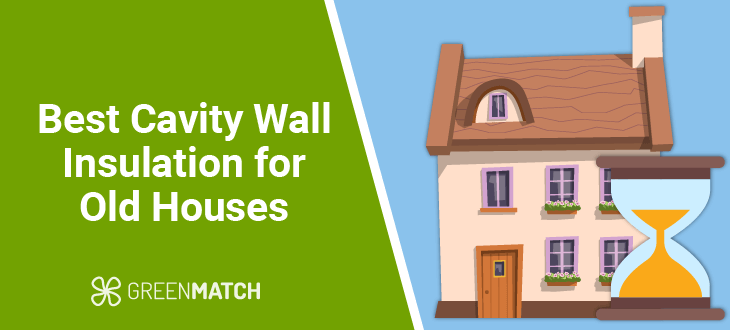
- Mineral wool is the best option for old homes, followed by polystyrene beads and polyurethane foam which are easier to retrofit.
- Not all older homes are suitable for installing insulation as some might not have adequate infrastructure.
- Insulation for old homes can save up to £405 in annual energy bills while costing between £1,000 to £4,600.
- If your property is suitable for insulation, it is worth installing as it can keep homes warm and lead to significant savings.
While newer homes have better insulation, older houses (over 25 years) may not be quite as fortunate. This can lead to significant heating inefficiencies and lower home value. While not all houses are suitable for insulation, some can certainly benefit from it. Let’s examine the best methods of wall cavity insulation and when it is appropriate for older properties.
If you’re looking to insulate your house, it’s best to have it properly assessed since each one has different needs. A reliable installer will give you the best prices and get you the right insulation materials. Rather than wasting days looking for the right professional, why not let us take the guesswork out of your search?
Instead of laboriously calling up companies, all you have to do is fill out a simple 30-second form. We’ll get you the best prices from up to 3 reliable installers in your area. Click the button below to get started.
- Describe your needs
- Get free quotes
- Choose the best offer
It only takes 30 seconds



What is the best cavity wall insulation for old houses
The best form of cavity wall insulation in old houses is mineral wool or polyurethane, depending on the type of installation. Mineral wool is great if you have the option of removing the wall or panelling, while polyurethane is ideal for less intrusive projects as it can be poured through holes in a wall. Generally, they both allow for adequate protection against the cold and decreased heating costs.
Which insulation material homeowners end up choosing may come down to how extensive their repair plans are. While mineral wools and natural fibres are better for extensive renovations, this may not be appropriate for all older homes. For more subtle repairs, polyurethane is a better way to go as it is a foam mixture.
| Insulation material | R-value (m²K/W) | U-value (W/m²K) | Average cost (per m2) |
|---|---|---|---|
| Mineral Wool | 2.5 - 3.3 | 0.030 - 0.040 | £13 - £17.5 |
| Sheep Wool | 3.5 - 4.5 | 0.22 - 0.29 | £17.5 - £22 |
| Polyurethane | 3.6 - 4.5 | 0.022 - 0.028 | £21.5 |
| Polystyrene (EPS) | 2.6 - 3.3 | 0.030 - 0.038 | £10 |
Insulation carries other benefits as well. Cavity wall sound insulation improves soundproofing as it fills internal gaps and reduces noise transfer. Rockwool and similar materials absorb sound, while installing rigid panels can ensure complete cavity filling for effective noise reduction.
Cavity wall insulation is not always an option for every older home. Many homes do not have a wide enough cavity for installing cavity wall insulation. Others may also suffer from excessive rubble and damage if the construction of the home is dilapidated. It’s best to consult an installer to have your property assessed.
Mineral wool

Mineral wool consists of yarn made from melted glass (glass wool) or stone (rock wool). It is spun and threaded together to form wool-like sheets or batts that can be inserted into wall cavities or inserted as mineral fibres. It can be blown into the walls like foam. Mineral wool made from stone is preferable to fibreglass as it has fewer health hazards to pose and is less prone to condensation (which can be an issue in older properties).
The reason it rests as a top choice for old homes is that it is far more effective at creating breathability and letting out moisture build up while being easy to install. Old homes are designed in such a way that they often have draughts, especially if they have a loft. The extra breathability comes in handy here, as experts state that it can let vapour pass and prevent degradation.
-
- Excellent insulation properties.
-
- Great for brick and stone walls.
-
- Water resistant.
-
- Can be up to 90% recycled content.
- Bad for wooden walls that are at risk of moisture damage.
- Comparatively costly installation.
- Cannot be passed through drill holes.
Sheep wool or natural fibre

Natural fibres like Sheep wool can be great in many situations where mineral wool won’t do. For one thing, it’s better to install around wood and timber elements like walls, columns, infrastructure, etc. This can prevent mould build-up and stop the wood from distorting.
Much like mineral wool batts and slabs, sheep wool comes in large chunks and won’t fit through drilled holes. This means they are better for either new constructions or extensive wall renovation. This would be best for a larger-scale renovation where a significant portion of the wall can be removed.
- Prevents dampening and moisture on wood elements.
- Natural and sustainable.
- Renewable resource.
- Easy to install.
- Good soundproofing.
- Relatively expensive.
- Harder installation which may not be appropriate for all cavity walls.
- Requires chemical treatment to ward off insects.
- Lower thermal efficiency than mineral wool.
Polyurethane foam
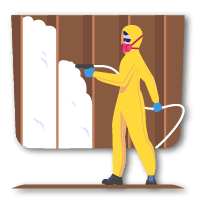
Polyurethane foam is one of the most common building materials used for insulation. Used in many different products, its popularity can be attributed to its versatility and higher thermal resistance. These same characteristics make it a viable material for old homes.
Aside from insulating against heat, polyurethane is also great for noise reduction (when compared with other plastic insulation materials). This can come in handy for old homes as they may have soundproofing issues.
Polystyrene can also be an affordable alternative to polyurethane but it’s best to be aware of its drawbacks. In terms of advantages, polystyrene fares better against moisture, can be more sustainable, and is cheaper but in most other categories it lags behind polyurethane. It is less temperature-resistant, less rigid, and less able to reduce noise.
- Easier installation than wool and natural fibres.
- Can be cheaper depending on the density of the material.
- Watertight and airtight.
- Good noise reduction.
- Polyurethane has fairly high temperature resistance.
- Can emit toxins and harmful Volatile Organic Compounds (VOCs) during and after installation.
- The airtight seal of polyurethane foam can restrict ventilation and create a bridge for moisture to travel from the outer wall to the inner wall.
- Can potentially emit odours.
- Cheaper polyurethane suffers from low durability.
If you’re not sure what material would work best for you, we recommend contacting an installer. A reliable installer can advise you on the best methods and materials while providing quick and easy installation of cavity wall insulation. However, it can be difficult to compare their rates on your own as it can be a hassle that requires compiling prices and vetting companies on your own. That’s why our service is quicker and easier.
We have a network of installers we’ve personally vetted to ensure top-of-the-line service. All you need to do is click the button below, fill out a 30-second form, and we’ll provide you with up to 3 free quotes with no payment obligations.
- Describe your needs
- Get free quotes
- Choose the best offer
It only takes 30 seconds



Costs & savings for cavity wall insulation in old houses
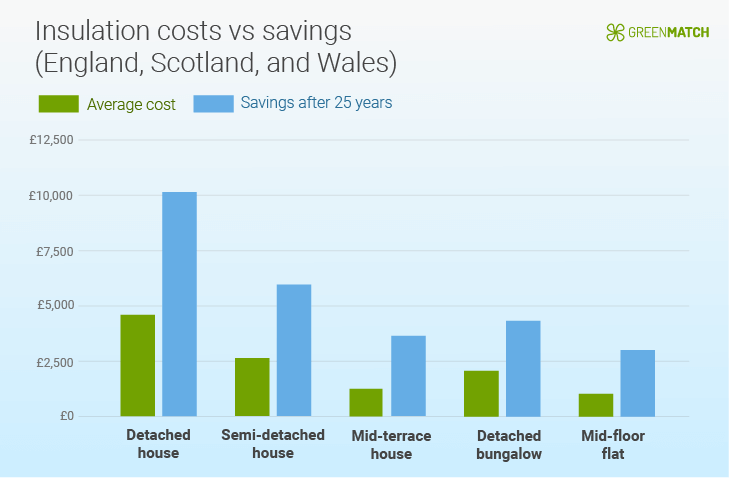
Cavity wall insulation costs in the UK are generally between £1,000 and £4,600 depending on the type and size of the the property. Cavity wall insulation costs for a 3-bed semi will be around £2,700. Annual savings can range from £110 to £405 with payback periods between 9 to 12 years in England, Scotland, and Wales.
| Type of home | Average cost | Annual savings | Payback period |
|---|---|---|---|
| Detached house | £4,600 | £405 | 11 years |
| Semi-detached house | £2,700 | £235 | 11 years |
| Mid-terrace house | £1,500 | £140 | 11 years |
| Detached bungalow | £2,100 | £175 | 12 years |
| Mid-floor flat | £1,000 | £110 | 9 years |
*This data is from Energy Saving Trust, April 2024. For more accurate prices, get a local installer QUOTE now!
While the figures above cover costs for England, Scotland, and Wales, the cost of wall cavity insulation in Northern Ireland can vary.
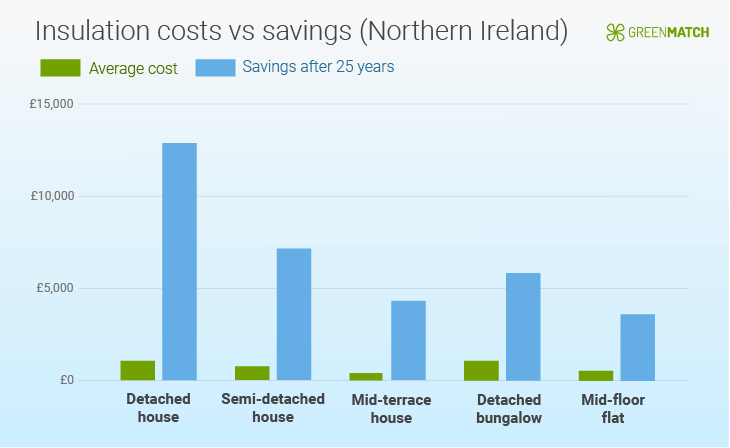
As is evident from the data, insulation costs in Northern Ireland vary wildly from other countries. With costs as low as £506 to £1,300, the payback period can be 3 to 4 years. Conversely, savings can be even higher, going up to £520.
| Type of home | Costs | Annual savings | Payback period |
|---|---|---|---|
| Detached house | £1,300 | £520 | 3 years |
| Semi-detached house | £820 | £300 | 3 years |
| Mid-terrace house | £530 | £175 | 4 years |
| Detached bungalow | £990 | £225 | 4 years |
| Mid-floor flat | £560 | £140 | 4 years |
*This data is from Energy Saving Trust, April 2024. For more accurate prices, get a local installer QUOTE now!
The discrepancy in prices can be attributed to the lower price of insulation in the region. Savings can also be higher in Northern Ireland because many homes heat with oil boilers which are often very inefficient. Therefore, with proper insulation, there is more of an impact of keeping in heat.
So, how long does cavity wall insulation last? Experts estimate an average of 25 years, which is more than twice its break-even point. You can continue reaping the benefits of insulation for at least a decade past that point.
If prices are a concern for you, there are government plans and incentives that can help improve your home. Grants for insulation include:
- ECO4: The Energy Company Obligation (ECO4) scheme allows homeowners to obtain grants that fund energy-efficient home upgrades in their homes. The scheme is aimed at people who are on a wide range of benefits programs. This can include measures such as heating systems, but also complete or partial home insulation.
- Great British Insulation Scheme: Designed for low-income homes, this scheme can potentially pay for the entire insulation work needed on a home (depending on the size of the job). This includes cavity walls (including party walls), solid walls, lofts, pitched roofs, flat roofs, under-floors, solid floors, park homes, and rooms in lofts.
- Sustainable Energy Authority of Ireland grants: A cavity wall insulation grant that only applies to Northern Ireland. Provides €800 for any type of apartment, €700 for mid-Terrace properties, €1,200 for semi-detached or end-of-terrace homes, and €1,700 for detached houses.
Pros and cons of wall cavity insulation for old homes
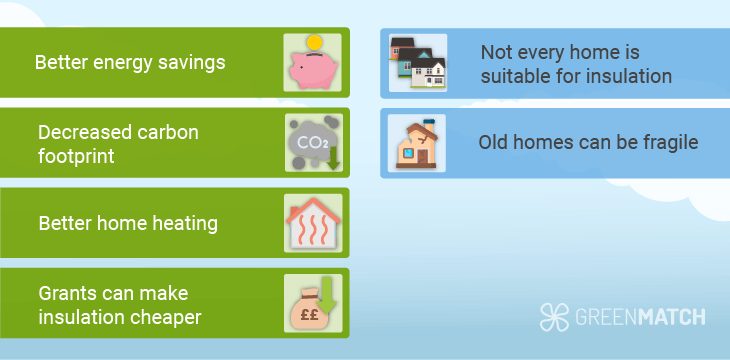
Pros:
- Better energy savings: Older homes can be very energy inefficient for several reasons. Insulation can cover up draughts and plug areas where air is escaping from.
- Decreased carbon footprint: Insulation can help decrease the average home’s carbon output by 670kg per year.
- Better home heating: On average, adequate insulation improves heating efficiency by 10%. Many older homes lack modern heating and insulation can be a cheaper option than installing new heating.
- Grants can make insulation cheaper: Both the ECO4 and Great British Insulation Schemes can ameliorate some of the prices for low-income homes. Both can offer full or partial payment for insulation.
Cons:
- Not every home is suitable for insulation: When it comes to older homes, there are structural issues that might prevent insulation installations, particularly for materials like mineral wool or natural fibres which require extensive renovation.
- Old homes can be fragile: Many old homes may not be able to withstand extensive repairs. Dilapidated walls can be an issue in particular, which is why cavity wall insulation in new builds is preferable.
Is old house wall cavity insulation worth it in the UK?
Insulating an old home in the UK should be done with caution as not all homes are suitable for it. If your home can accommodate insulation, it can be worth it as it can save up to £405 per year. Insulation can be an effective energy-saving measure that is cheaper and less intrusive than changing your heating system.
Aside from the savings on bills, it also decreases the load on the energy grid while lowering the average home’s carbon footprint by 1,500kg of CO2 per year. This is also why the government offers grants like the ECO4 scheme, which can make insulation more than worth it.
If you’re not sure if your home is viable for insulation, you’ll need the help of a reliable installer. You need to be sure they have your home’s best interest in mind, especially with older homes. Finding one ordinarily takes days of research and frustrating price comparisons and still won’t ensure you’ve found adequate help. That’s why our service is a far better alternative.
All you need to do is fill out a 30-second form and we’ll find you quotes from up to 3 reliable installers in your area. We’ve vetted them personally so you can be sure they are up to the task. Click the button below to get the best prices.
- Describe your needs
- Get free quotes
- Choose the best offer
It only takes 30 seconds



FAQ
While not all older properties are suitable for cavity wall insulation, it does have benefits for those that are. It can decrease costs and a home’s carbon footprint while costing less than most other efficiency measures.
It’s best to consult an expert before insulating old cavity walls since there might be structural issues that would make it less ideal. Consulting a professional insulation expert is recommended.
Yes. Cavity wall insulation can make homes warmer and allow for decreased carbon emissions. Despite the cost, it can break even in 3 to 11 years.

Rawal Ahmed is a writer at GreenMatch with an interest in sustainability and a background in tech journalism and digital marketing.
We strive to connect our customers with the right product and supplier. Would you like to be part of GreenMatch?

